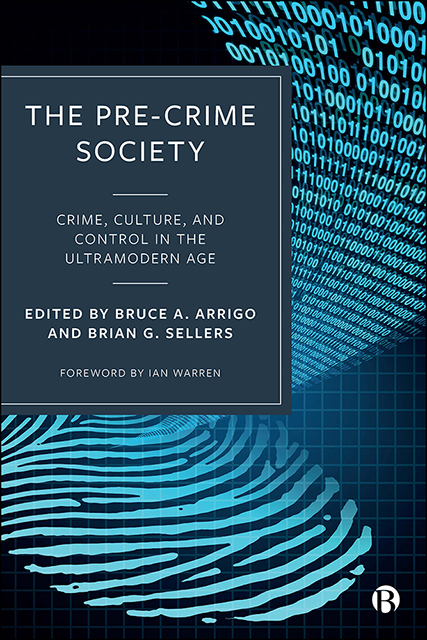Book contents
- Frontmatter
- Dedication
- Contents
- Notes on Contributors
- Foreword
- Introduction: The Ultramodern Age of Criminology, Control Societies and ‘Dividual’ Justice Policy
- Part I Theories, Theorists and Theoretical Perspectives
- Part II Institutions, Organizations and the Surveillance Industrial Complex
- Part III Dataveillance, Governance and Policing Control Societies
- Part IV Systems of Surveillance, Discipline and the New Penology
- Part V Globalizing Surveillance, Human Rights and (In)Security
- Afterword: ‘Pre-Crime’ Technologies and the Myth of Race Neutrality
- Index
14 - Mass Monitoring: The Role of Big Data in Tracking Individuals Convicted of Sex Crimes
Published online by Cambridge University Press: 14 April 2023
- Frontmatter
- Dedication
- Contents
- Notes on Contributors
- Foreword
- Introduction: The Ultramodern Age of Criminology, Control Societies and ‘Dividual’ Justice Policy
- Part I Theories, Theorists and Theoretical Perspectives
- Part II Institutions, Organizations and the Surveillance Industrial Complex
- Part III Dataveillance, Governance and Policing Control Societies
- Part IV Systems of Surveillance, Discipline and the New Penology
- Part V Globalizing Surveillance, Human Rights and (In)Security
- Afterword: ‘Pre-Crime’ Technologies and the Myth of Race Neutrality
- Index
Summary
Introduction
In the United States, compared to persons convicted of violent, property or white-collar crimes, individuals convicted of sex crimes are arguably one of the most highly monitored groups of offenders in contemporary times. While historically this was not always the case, sensationalized media accounts of high-profile sexual assault-homicide cases, particularly those committed against children, changed the sociolegal landscape—from one of treatment amenability to one of punishment and deterrence (Sutherland, 1950; Jenkins, 1998). As a result, scrutiny of these individuals by lawmakers, criminal justice actors, and the public has continued to intensify over time. This level of scrutiny, in combination with new ways of managing these individuals’ access to or restriction from social spaces, spurred on by media narrative, public outcry, and reactionary policy making, led to numerous changes in law (Jenkins, 1998; Lynch, 2002; Sample & Kadleck, 2008; Budd & Mancini, 2017). Legislation crafted to monitor and track these individuals in communities started to proliferate and has become institutionalized at both the federal and state level (Jenkins, 1998; Lynch, 2002; Sample & Kadleck, 2008). A key aspect to implement this legislation was to leverage technology in conjunction with personnel power (e.g. law enforcement) to accomplish these legislative aims.
Digital technology, such as databases to prevent, respond to, and investigate crimes, and technological monitoring, such as Global Positioning System (GPS) devices, has played an ever-increasing role in criminal justice work (Eisenberg, 2017). The use of these technologies has become particularly prominent in tracking and monitoring individuals convicted of sex crimes (Eisenberg, 2017; McJunkin & Prescott, 2018). Improvements in technology and the ability to capture and store large quantities of data have evolved; therefore, the ways in which individuals who have been convicted of committing a sex crime(s) are monitored have become more sophisticated. This chapter will focus on the ways persons convicted of sex crimes are contemporarily monitored, specifically through two mechanisms: sex offender registration and notification (SORN) and electronic monitoring (EM). Both of these monitoring strategies amass large quantities of data (e.g. personal information, location tracking information) that are gathered, housed and maintained by law enforcement and various other agencies. While law enforcement generally has a primary role in monitoring this group of people, at the community level other branches of criminal justice, such as probation and parole, are also tasked with the day-to-day monitoring of these persons if they are still under correctional supervision.
- Type
- Chapter
- Information
- The Pre-Crime SocietyCrime, Culture and Control in the Ultramodern Age, pp. 315 - 340Publisher: Bristol University PressPrint publication year: 2021



